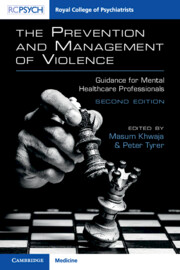Book contents
- The Prevention and Management of Violence
- The Prevention and Management of Violence
- Copyright page
- Dedication
- Contents
- Contributors
- Preface
- Abbreviations
- Section 1 General Aspects of Management
- Section 2 Medical and Psychological Intervention
- Section 3 Violence in Different Settings
- Introduction to Section 3
- Chapter 9 Management of the Risk of Violence in the Community
- Chapter 10 Management of Violence in Acute Medical Hospital Settings
- Chapter 11 Forensic Psychiatry and Adult Inpatient Secure Settings
- Chapter 12 Management of Violence in Prisons
- Section 4 Management in Other Groups
- Section 5 Violence and Society
- Section 6 Engagement and Understanding
- Index
- References
Chapter 12 - Management of Violence in Prisons
from Section 3 - Violence in Different Settings
Published online by Cambridge University Press: 09 May 2023
- The Prevention and Management of Violence
- The Prevention and Management of Violence
- Copyright page
- Dedication
- Contents
- Contributors
- Preface
- Abbreviations
- Section 1 General Aspects of Management
- Section 2 Medical and Psychological Intervention
- Section 3 Violence in Different Settings
- Introduction to Section 3
- Chapter 9 Management of the Risk of Violence in the Community
- Chapter 10 Management of Violence in Acute Medical Hospital Settings
- Chapter 11 Forensic Psychiatry and Adult Inpatient Secure Settings
- Chapter 12 Management of Violence in Prisons
- Section 4 Management in Other Groups
- Section 5 Violence and Society
- Section 6 Engagement and Understanding
- Index
- References
Summary
Violence is more common in prisons than in the community. Mental disorders are over-represented in this population, and are associated with an even higher risk of perpetrating or becoming a victim of prison violence. Violence in this environment has unique characteristics, strongly influenced by gangs and an illicit economy. This chapter reviews the causes and management of prison violence, and the role of the mental health clinician in the assessment and management of violence in prison relating to mental disorder. The early impact of COVID-19 on prison violence is described.
- Type
- Chapter
- Information
- The Prevention and Management of ViolenceGuidance for Mental Healthcare Professionals, pp. 187 - 200Publisher: Cambridge University PressPrint publication year: 2023



